Tuesday 30 August 2011
Gray-backed Sportive Lemur
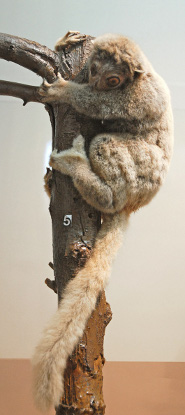
The Gray-backed Sportive Lemur (Lepilemur dorsalis) resides in the country of Madagascar. It a gray with white black in color with a yellowish color belly. This lemur is not very big weighing roughly 1 to 2.5 lbs and their tail is approximately 9.8 to 12 inches (24.8cm - 30.4cm) long. They are able to climb and hang from trees either by their arms or their tails which they curl around a branch like a knot.
'Lemur' means ghost or spirit in latin, and is very appropriate due to their spooky look with their big eyes and little ears. Lemurs reside only in
Madagascar and no other countries and have a very unique and distinctive look.
Almost ninety percent of the rainforest has been destroyed by loggers, endangering the gray-backed sportive lemur's existence as well as all the species of lemurs. Some lemurs are killed by superstitious people who are frightened by their eerie look. Sometimes this species is hunted for food when there is nothing else to eat.
Males live alone in solitude and visit one or more females at night during mating season. Each female will give birth to only one offspring. Once the offspring is born, usually somewhere between September and November, the mother will leave the child on a branch tucked away while they rummage for food. The mother will call to the child sounding like a kiss and the child will make the same sound back so the mother is assured of its safety.
The gray-backed sportive lemur is primarily a leaf-eating species, but will eat fruit and bark to supplement the diet. They possess long tails and binocular vision to focus in on their territory and finding food. The lemur is a nocturnal animal and at night swings vertically from tree limb to tree limb leaping onto branches. The lemur re-ingests its feces which helps to break down the fiber in the leaves they eat. The gray-backed sportive lemur is a very territorial animal.
Picture of the Gray-backed Sportive Lemur by
dalbera, licensed under the Creative Commons
Attribution 2.0 Generic
license.
You can help spreading the word about this animal by liking it on facebook
Permanent Link
Monday 29 August 2011
Tamarisk gerbil - Multi-colored Rodent
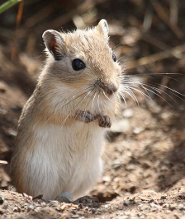
The Tamarisk gerbil (
Meriones unguiculatus) is also known as Mongolian or Tamarisk Jird and also called 'sand rat'. These small burrowing desert rodents have long hind legs used for leaping and running away from predators. They were named by Milne-Edwards.
Tamarisk gerbils normally have 15-18 centimeters (6-7 inches) head measurement, and their furry tails can extend up to 15 centimeters (6 inches) and are bushy towards the tip. These cute animals are preferred pets due to their gentle temperament. These social creatures vary in coat’s color from Yellow to Sandy or Gray or Dark Brown otherwise a classier Golden Agouti, Black, Argente, Lilac, Dove, Sapphire, Silver or Ivory Cream and others.
However, it was not until 1954 when they became popular pets but prior to that they roamed the deserts and steppes of different regions in the world. While these rodents are natural carriers of plagues and diseases, they are kept as pets and used as experimental animals. Like the Hamster, they are used for research or scientific testing.
These animals are abundant everywhere from the Mongolian desert, to the
Russian Federation,
Kazakhstan,
Kyrgyzstan,
Tajikistan,
Turkmenistan,
Uzbekistan and also in
China. However, while considered rare in some areas they are not definitely considered endangered. However, the possibility of extinction may depend greatly on habitat degradation, water loss or droughts and least likely on human disturbance.
These animals do not usually grow in colonies but normally live in family groups. The female gerbil usually gives birth up to 3 times per year. They thrive on
grassland, scrublands,
desert, plantation and terrestrial areas. They survive on cold and dry winters and also on hot summers. Those family groups of gerbils who live in deserts may grow in extinction due to trampling of camels and other large animals.
These intelligent mammals live in burrows with around 10-20 exits. These exits provide a way of escape for their common predators like snakes and birds of prey. Tamarisk gerbils in the wild feed on seeds and vegetation, domesticated gerbils on the other hand may be fed with food mix usually labeled as hamster and gerbil food.
You can help spreading the word about this animal by liking it on facebook
Permanent Link
Tuesday 23 August 2011
California Condor - Wearing its Heart on its Sleeve
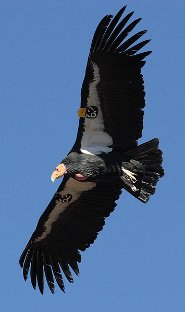
The California condor (
Gymnogyps californianus) is among the largest of the world's flying birds. They will fly as far as 150 miles a day in search of food. These birds have a lifespan of up to 60 years, making it one of the longest-living birds ever. They are often found near large, tall trees or cliffs, where they can build their nests.
These distinctive vultures have very long necks and bald heads, allowing them to feed within a carcass. Bodily fluids will not get stuck to them due to the way they are built. When they need to keep warm, they can tuck their heads into their fluffy, feathery collars. Amazingly, the skin color of these birds change depending on their emotions. The colors can vary from yellow to a neon-green to a glowing red-orange, to even a purplish-blue.
California condors scavenge for food and will often remain high in the air, circling around a newly found meal to signal to other condors that it is time to eat. They feed primarily on carrion, and will search for miles to find it. Besides
human beings (via hunting), the condors major predators include eagles, coyotes, snakes and mountain lions. These animals primarily attack young condors or eat condor eggs
The average weight of the California condor is 8 to 13 kilograms (18 to 29 pounds). Their wingspan can be nearly 3 meters wide, or 9.5 feet, the largest wingspan of any other bird in North America. These birds mate for life and lay one egg every two years.
The California condor resides in the mountains of south-central California, the Grand Canyon and Zion National Park. California condors are on the critically endangered list. There are only about 400 of these birds left on the planet, including the nearly 200 that are in the wild. When they became extinct in the wild, a captive breeding program began to keep them alive. The condor chicks who are born into captivity are fed with a condor hand puppet, making sure they don't become to attacked to their human caretakers.
You can help spreading the word about this animal by liking it on facebook
Permanent Link
Tuesday 16 August 2011
Cotton-top Tamarin - Rock Star of the Forest
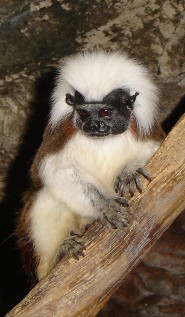
The Cotton-top tamarin (
Saguinus Oedipus) is a New World monkey that is native to the humid and dry deciduous forests of northern
Columbia. This little monkey is instantly recognizable for the shock of white hair on top of its head that falls back over its shoulders, making it look like an aging rock star or an eccentric mad scientist.
The Cotton-top is a barefaced tamarin, so characterized because the facial hair is fine and short and makes the animal appear to have a hairless face. Below the white crest hair on the head, the animals have a mottled gray-brown coat on their shoulders, back and rump, white limbs, and reddish patches on the inner thighs. The average height for both males and females in the wild is 23.2 centimeters (9.13 inches), including the tail, with an average weight of 450 grams (15.9 ounces).
The habitat of the Cotton-top is between the understory and the canopy of the tropical forests, where they forage for insects, fruit and plant exudates (tree sap and gum). Cotton-tops require a high-energy diet due to their diminutive size and fast metabolisms, and they play an important ecological role as being a highly efficient seed-disperser in their tropical ecosystem.
The Cotton-top tamarin is a highly social animal, and they live in cohesive groups of up to a dozen individuals that are usually headed by a dominant breeding female. Care of the young in the group seems to be a shared responsibility, with mothers, siblings and unrelated adult males taking turns carrying and grooming infants and young. Cotton-tops also have a highly developed system of vocal communication, using whistles, chirps, hoots and staccato long calls. Researchers have identified 38 distinct calls that appear to conform to grammatical rules.
The range of the Cotton-topped tamarin in the wild has been greatly reduced due loss of habitat through deforestation, and is now limited the remnant and secondary-growth forests of northern Columbia. The wild population was also severely impacted by the capture and export of tamarins for medical research and the pet trade through the 1970s. Today the wild population of the Cotton-topped tamarin is estimated to be less than 6,000 individuals, and the species is listed as one of the world’s 25 Most Endangered Primates.
You can help spreading the word about this animal by liking it on facebook
Permanent Link
Monday 15 August 2011
Bongo - World's Largest Forest Antelope
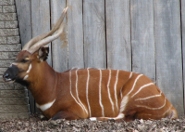
The Bongo (
Tragelaphus eurycerus) is an antelope species that can be found in certain parts of Africa. The Bongo is the heaviest and largest forest antelope. The animal is usually reddish orange in color with about 10-15 distinct vertical white stripes. The coat color will grow darker as the animal ages. The animal has a black muzzle with a white cheek spots.
One of the unique features of the Bongo antelope is that it is one of only animal species in the world where horns can be found on both male and female sexes. The Bongo's horns can grow up to 75-100 cm long and can be a bit wavy in appearance. Horns of females are usually longer, thinner and more parallel.
Dimensions
Length: 5.6-8.3 ft. or 170-250 cm
Shoulder Height- 3.6 to 4.3 ft. or 110-130 cm
Tail Length- 18 to 26 in. or 45 to 65 cm
Weight- 525 to 880 lb. or 240 to 400 kg
Animal Behavior
The Bongo is a solitary and shy animal that usually move in singles or small pair groups. An average sized group may consist of about 9 or less females with their young. If startled, the Bongo will quickly flee into the forest. When running, Bongo horns are held back to prevent them from tangling with the vegetation. Bongos are also nocturnal animals that are mostly active between dusk and dawn. The animal loves to polish their horns, wallow in the mud and rub themselves against the tree. Their vocalizations include snorts, grunts, a moo-like call and a bleat-like call used when alarmed. The main predators of the Bongo are men and leopards.
Habitat
Bongos can be found in the dense African forests or jungles with altitudes of about 4,000 meters of central Africa. There is a little population in Kenya and some other West
African countries. Countries where Bongos live include Cameroon, Burkina Faso, Congo, DRC, Equatorial Guinea, Gabon, Guinea, Ghana, Mali, Sierra Leone, Liberia, Ethiopia, Cote d'Ivoire, Sudan, Niger and Guinea-Bissau. Kenya is the only country where the animal can be found in the wild.
Diet
Bongos are herbivores and their diet consist of bushes, trees, barks, vines, rotting trees, herbs, grasses, cereals, fruits, shrubs and roots. As nocturnal animals they usually graze during the night. The animal has a prehensile tongue that allows it feed off easily from high vegetations.
At present, the Bongo is regarded as a threatened animal with dwindling numbers. Deforestation and hunting has greatly reduced their numbers. The animal is already reportedly considered to have gone extinct in three African countries, which are
Uganda,
Togo and
Benin.
You can help spreading the word about this animal by liking it on facebook
Permanent Link
Friday 12 August 2011
The Calabar Anwantibo - Nature's Hanging Lover
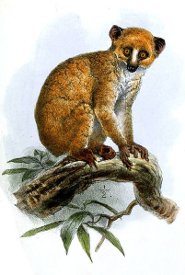
The Calabar angwantibo (
Arctocebus calabarensis) is sometimes called the Calabar potto due to its close relation with the Pereodictus potto. The animal is classified as a strepsirrhine primate of the Lorisidae family. The animal can be found in the rain forests of west Africa, covering a range of
Cameroon,
Nigeria and
Equatorial Guinea.
Orangish-yellow on its back with grey or white fur on its belly, the primate has a white line traveling from the tip of its nose to its forehead. With his wide, round eyes, the Calabar angwantibo is a beautifully startling animal to look at. The animal has a very short index finger which makes it easy to grip branches and a second toe with a specialized claw which is used for self-grooming. Interestingly, the Calabar angwantibo is the only primate in the world to have a third eyelid (nictating membrane); like those you see in cats and dogs.
At maturity, the angwantibo weighs between 266 and 465 grams (9.38 to 16.4 ounces). The tiny primate is active by night and spends most of its life in lower part of the trees than its primate cousins, hovering between 5 and 15 meters (16.4 to 49.21 feet) above ground. The angwantibo spends his day sleeping whilst hanging from a tree branch. At night, the primate hunts for its staple diet: insects. Though the angwantibo is not a picky eater, it does favor caterpillars above any other insect in the jungle.
The male angwantibo is a solitary hunter and has a range to himself. His range, though, does overlap the range of several females with whom he forms a social bond. The animals mate upside down, whilst hanging from a tree branch during the final phase of the female angwantibo’s estrous cycle. After a gestation period of approximately four months, a single infant is born.
When confronted by a predator, like the small carnivores and other natural predators of the African jungle, the angwantibo curls into a ball with its head tucked into its armpit. Mouth open, the primate is ready to bite and hang on if the predator persists in its attack. The angwantibo is considered of least concern when it comes to threat level as they have great numbers and man interferes with them very little. Primary threats to the species are its natural predators and deforestation.
You can help spreading the word about this animal by liking it on facebook
Permanent Link
Thursday 11 August 2011
Bushbuck - The Fighting Antelope
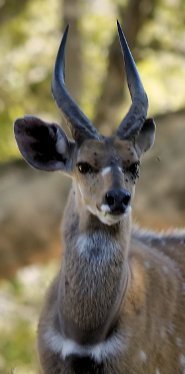
The Bushbuck (Tragelaphus scriptus) is a very unusual specimen of the antelope family. It has several distinguishing characteristics that make it stand out from the herd, so to speak. An unusual coat, feisty temper and odd gait are amongst the traits that make the Bushbuck such a fascinating creature.
Instead of living on open grasslands and savannas, as many of its cousins do, the Bushbuck is a forest-dwelling antelope. It makes its home in a wide array of forest types. Rainforests, savanna-forest mosaics, light woodlands, and savanna bush forests are amongst its favorite habitats. It is also widely dispersed, and can be found across many parts of Africa, including
Senegal, Ethiopia, Eritrea, Angola and Sahel and down to the Cape of
South Africa.
Because the Bushbuck is a forest-dwelling antelope, it is a browser, not a grazer. While grass certainly isn't off the menu, the Bushbuck's main diet consists of buds, shrubs and herbs, with the occassional snack of fruits, tubers and flowers thrown into the mix as well. It tends to be active more at night than during the day, especially if its forest home has humans living nearby, in which case the entire Bushbuck population of that region may be entirely nocturnal.
In appearance, the Bushbuck displays a unique and beautiful coat. The color of the coat can vary from red-brown, dark olive to almost black, depending on the habitat of that particular Bushbuck. Most Bushbucks also sport unusual white striping and splotching on their sides, as well as white patches on legs, ears, throat and tail. These white splotches and stripes help individual members identify one another and also act as a warning signal when danger is near. The white markings on some populations is more pronounced than on others, depending on genetics and habitat.
The Bushbuck is a medium sized antelope, growing to be between 80-90 centimeters at the shoulder and weighing anywhere from between 45 and 80 kilograms, with males being generally larger. The males grow spiraled horns that can be up to 55 centimeters long. Overall, the Bushbuck ranges from 110-150 centimeters in length, and is sometimes considered one of the more dangerous mid-sized antelope. Wounded Bushbucks have been known to charge and attack hunters or other predators. Natural predators include the
leopard, hyena,
wild dogs, crocodiles and the occasional
lion.
The Bushbuck is a fascinating creature that merits more study and interest, despite being so widespread and relatively common. Their beautiful appearance, feisty nature and adaptability make it one of the most unique antelopes found in Africa.
Picture of the bushbuck by Hans Hillewaert, licensed under
Creative Commons Attribution-Share Alike 3.0 Unported license.
You can help spreading the word about this animal by liking it on facebook
Permanent Link
Wednesday 10 August 2011
Red Bellied Monkey - Cheek Pouches
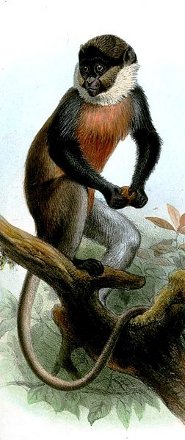
The Red-Bellied Monkey (
Cercopithecus erythrogaster) is a native of Benin and Nigeria. They are unique because of their small stature, coloring patterns, and cheek pouches. This beautiful little monkeys became officially endangered in 2000, mainly due to destruction of their habitat by humans.
Physical Attributes
This petite species is approximately 46 cm (18 inches) long. The female weighs around 2 kg (4.4 pounds), and the male weighs around 4.5kg (10 pounds). The monkey is famous for its red belly and white throat. The combination of colors makes them unique and easy to identify. They are arboreal, using all four legs to move horizontally along tree branches. They do occasionally leap, but prefer the safer method of using all four limbs.
Food Sources
They are primarily fruit eaters, but they are opportunistic and will consume insects, leaves, and even crops when available. They have cheek pouches that allow them to forage for food, then store it until they reach a safe place to eat. This unique feature separates them from other monkeys in their area. They are also able to carry large amounts of food in these pouches to other members of their group.
Habitat
The Red Bellied Monkey lives in wetlands along rivers and forests in Southwestern
Nigeria and Southern
Benine. Their natural habitat has fallen victim to destruction by humans, their only known predator. They remain classified as endangered although they have been doing well in captivity. They have been recovering in the Guineon Forests of the West Africa Biodiversity Hotspot. They are also flourishing in the Okomu National Park in Nigeria.
Social Life
The monkeys like to live in small groups of five to ten. However, there have been groups as large as thirty observed. They are social within the group, but separate themselves from other groups. They are polygynous and breed every one to five years. Females have a single baby after 150 – 213 days of gestation. In captivity, these fascinating creatures can live up to twenty four years. Due to their endangered status, little is known about their life span in the wild.
Communication
The monkeys use various methods of nonverbal communication to warn off animals invading their territory. Staring, staring with open mouths, and head bobbing are all different warning methods they use. They also employ verbal communication, but little is known about the methods and meanings.
These peculiar creatures are trying to make a comeback in captivity. They are robust and reproduce regularly. The destruction of their habitat has made it impossible for them to maintain themselves in their natural habitat. Very few monkeys have the cheek pouches and small stature that make the red bellied monkeys rare.
You can help spreading the word about this animal by liking it on facebook
Permanent Link
Friday 05 August 2011
Southern Tamandua - The Strong Arm Anteater
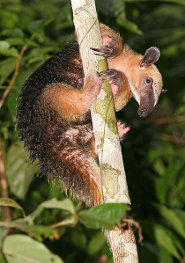
The Southern Tamandua (Tamandua Tetradactyla) is a species of Anteater native to South America. Much smaller than its 8 foot cousin the
Giant Anteater. It weighs in at about 4.5 kg (9.9 lbs) and has an average body length of 535 mm (21.1 in) to 880 mm (31.5 in.) Sometimes called "Collared Anteater" or "Lesser Anteater, the Southern Tamandua can be found in varying climates ranging from tropical rain forests to dryer savannas. Ideal habitats for this species include those with nearby rivers or streams as well as dense woods.
Trees are important as they spend a great deal of time in them both to remain safe from predators and to find food. The Tamandua's diet consists of (as you might guess) ants, as well as termites, and assorted other insects even bees. Most of the feeding takes place during the night because the Southern Tamandua is primarily nocturnal hunting at night and nesting in tree trunks and abandoned burrows during the day.
The Southern Tamandua is a solitary animal that does not tend toward aggression but does have some interesting methods of defense when threatened. One important aspect of the species is its notably strong forearm and long curved claws. these are typically used to break open nests and dig out their prey, however, it is not uncommon for the Tamandua to hang from its prehensile tail and use its powerful forearms to defend itself from aggressors. If the strong arm and long claw method doesn't work, Tamandua Tetradactyla has a defensive backup. Much like a skunk, the Southern Tamandua can emit a scent from its anal gland that will discourage those who aggravate it.
The biggest threat to the Southern Tamandua is posed by humans. According to the IUCN Red List, the Tamandua is of "least concern" due to its wide distribution, however The Convention on International Trade in Endangered Species lists Tamandua Tetradactyla as endangered due to widespread hunting. Furthermore, depletion of rain forests will eventually lead to a significant loss of habitat and food for these unique animals.
Picture of the Southern Tamandua by
birdphotos.com , licensed under
Creative Commons Attribution 3.0 Unported license.
You can help spreading the word about this animal by liking it on facebook
Permanent Link
Wednesday 03 August 2011
Brown Antechinus - The Pouchless Marsupial
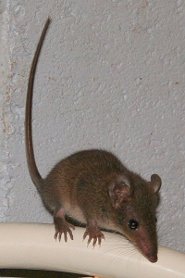
The
Brown Antechinus (
Antechinus stuartii), is also known by its other two names: Stuart's Antechinus and Macleay's Marsupial mouse. The Brown Antechinus is a carnivorous marsupial within the family Dasyuridae. The animal has been labeled the same as several other species until recently, when it was discovered, or decided, that they were all separate animals: the Agile Antechinus, the Subtropical Antechinus, the Tropical Antichenus and the
Yellow-footed Antechinus.
The Brown Antechinus has a body length of 9.5 to 11 cm (3.7 in to 4.3 in) and has a tail length of between 10 to 12 cm (3.9 in to 4.7 in). The antechinus is a brown color along its sides and back with a cream to white underbelly. The ears are small and rounded, set high upon the head and the eyes are small, black orbs located midway between the nose and ears. The Brown Antechinus has five toes on each of its four feet and is an excellent climber.
The antechinus is nocturnal, for the most part, and is arboreal, meaning that it lives primarily in trees. The females of the species build large, communal nests which are shared by many of the same species. Interestingly, the males die after their very first two-week breeding season due to the stress of the period and the exhaustion of mating. Even though they are considered a marsupial, the females possess no pouch; the litter of six to seven young attach themselves to the mother's teats and hang on for deaf life; literally!
The Brown Antechinus can be found from southeastern Queensland to Kioloa, New South Wales, east of the Great Divide Range on the continent of
Australia. The antechinus is almost exclusively found in wooded habitats. The diet of the antechinus is comprised of insects: beetles, spiders and cockroaches, though the antechinus will eat almost anything it can find if insects are scarce.
The conservation status of the Brown Antechinus is labeled as 'least concern'. This means that the antechinus is at the very bottom of the list when it comes to endangered species; not being at all threatened. The antechinus has natural predators: snakes, lizards and predatory birds, but is not preyed upon by man.
Picture of the brown antechinus by Glen Fergus, licensed under the
Creative Commons Attribution-Share Alike 2.5 Generic license.
You can help spreading the word about this animal by liking it on facebook
Permanent Link
Monday 01 August 2011
The Segregated Anoa
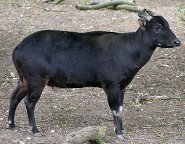
The
Anoa (
Bubalus depressicornis), living in
Indonesia are similar to water buffalo. In Indonesia, they enjoy the rainforest, which has not yet been devastated by man. Weighing 150-300 kg (330-660 lbs), these four-legged mammals resemble deer in appearance. Most Anoa reside on the island of Sulawesi in the Southern Pacific Ocean. However, there are a few which are found on Buton, another Indonesian island.
The Anoa segregate themselves into two groups. Similar to the old clans in Scotland, there are highlanders and lowlanders. All of the Anoa on Buton are highlanders, going by the name Mountain Anoia. Different people have given the Mountain Anoa varying names, one of which is Anoa de Montana (Anoa of the Mountain). Although there are many different names for this Anoa, these reflect the variety of societies and languages in the area, not the Anoa's diversity. There are only the highlanders and lowlanders. While Buton has only Mountain Anoa, both species live on Sulawesi.
The other main difference between the two Anoas is their size. The Lowland Anoa are some of the smallest wild cattle. They stand only 90 cm tall (35 in.) at the shoulder, perhaps more closely resembling a young fawn in appearance than a fully grown buck. In contrast, the Mountain Anoa are more similar to mature deer in their stature.
While the Anoa segregate themselves by living in the mountains or preferring the abundance of plants available for eating at lower elevations, they live largely similar social lives. The Anoa prefer to spend their days alone, or perhaps in pairs. Each of the females will likely have a single young annually. This lonely social life is common in all Anoa.
The Anoa is a largely unknown animal. Although they have been studied by researchers and are known by the people of Indonesia, most of the world is unfamiliar with these animals. A lack of appreciation for these creatures has combined with their solitary lifestyle and low reproduction rate to their decline. The Anoa are endangered. Since the 1960s, their population has fallen. Estimates today are around 10,000 for the total population of both species combined. The two factors contributing to the Anoa's decline are the destruction of their rain forest environment and hunting.
Hopefully with proper education, people will come to know and appreciate the Anoa.
Picture of the lowland Anoa by 'The Land', photographed May 2011 in Marwell Zoo, Hampshire, UK., licensed under
Creative Commons Attribution-Share Alike 3.0 Unported license.
You can help spreading the word about this animal by liking it on facebook
Permanent Link
 The Gray-backed Sportive Lemur (Lepilemur dorsalis) resides in the country of Madagascar. It a gray with white black in color with a yellowish color belly. This lemur is not very big weighing roughly 1 to 2.5 lbs and their tail is approximately 9.8 to 12 inches (24.8cm - 30.4cm) long. They are able to climb and hang from trees either by their arms or their tails which they curl around a branch like a knot.
The Gray-backed Sportive Lemur (Lepilemur dorsalis) resides in the country of Madagascar. It a gray with white black in color with a yellowish color belly. This lemur is not very big weighing roughly 1 to 2.5 lbs and their tail is approximately 9.8 to 12 inches (24.8cm - 30.4cm) long. They are able to climb and hang from trees either by their arms or their tails which they curl around a branch like a knot.
 The Tamarisk gerbil (Meriones unguiculatus) is also known as Mongolian or Tamarisk Jird and also called 'sand rat'. These small burrowing desert rodents have long hind legs used for leaping and running away from predators. They were named by Milne-Edwards.
The Tamarisk gerbil (Meriones unguiculatus) is also known as Mongolian or Tamarisk Jird and also called 'sand rat'. These small burrowing desert rodents have long hind legs used for leaping and running away from predators. They were named by Milne-Edwards. The California condor (Gymnogyps californianus) is among the largest of the world's flying birds. They will fly as far as 150 miles a day in search of food. These birds have a lifespan of up to 60 years, making it one of the longest-living birds ever. They are often found near large, tall trees or cliffs, where they can build their nests.
The California condor (Gymnogyps californianus) is among the largest of the world's flying birds. They will fly as far as 150 miles a day in search of food. These birds have a lifespan of up to 60 years, making it one of the longest-living birds ever. They are often found near large, tall trees or cliffs, where they can build their nests. The Cotton-top tamarin (Saguinus Oedipus) is a New World monkey that is native to the humid and dry deciduous forests of northern
The Cotton-top tamarin (Saguinus Oedipus) is a New World monkey that is native to the humid and dry deciduous forests of northern  The Bongo (Tragelaphus eurycerus) is an antelope species that can be found in certain parts of Africa. The Bongo is the heaviest and largest forest antelope. The animal is usually reddish orange in color with about 10-15 distinct vertical white stripes. The coat color will grow darker as the animal ages. The animal has a black muzzle with a white cheek spots.
The Bongo (Tragelaphus eurycerus) is an antelope species that can be found in certain parts of Africa. The Bongo is the heaviest and largest forest antelope. The animal is usually reddish orange in color with about 10-15 distinct vertical white stripes. The coat color will grow darker as the animal ages. The animal has a black muzzle with a white cheek spots.  The Calabar angwantibo (Arctocebus calabarensis) is sometimes called the Calabar potto due to its close relation with the Pereodictus potto. The animal is classified as a strepsirrhine primate of the Lorisidae family. The animal can be found in the rain forests of west Africa, covering a range of
The Calabar angwantibo (Arctocebus calabarensis) is sometimes called the Calabar potto due to its close relation with the Pereodictus potto. The animal is classified as a strepsirrhine primate of the Lorisidae family. The animal can be found in the rain forests of west Africa, covering a range of  The Bushbuck (Tragelaphus scriptus) is a very unusual specimen of the antelope family. It has several distinguishing characteristics that make it stand out from the herd, so to speak. An unusual coat, feisty temper and odd gait are amongst the traits that make the Bushbuck such a fascinating creature.
The Bushbuck (Tragelaphus scriptus) is a very unusual specimen of the antelope family. It has several distinguishing characteristics that make it stand out from the herd, so to speak. An unusual coat, feisty temper and odd gait are amongst the traits that make the Bushbuck such a fascinating creature. The Red-Bellied Monkey (Cercopithecus erythrogaster) is a native of Benin and Nigeria. They are unique because of their small stature, coloring patterns, and cheek pouches. This beautiful little monkeys became officially endangered in 2000, mainly due to destruction of their habitat by humans.
The Red-Bellied Monkey (Cercopithecus erythrogaster) is a native of Benin and Nigeria. They are unique because of their small stature, coloring patterns, and cheek pouches. This beautiful little monkeys became officially endangered in 2000, mainly due to destruction of their habitat by humans.  The Southern Tamandua (Tamandua Tetradactyla) is a species of Anteater native to South America. Much smaller than its 8 foot cousin the
The Southern Tamandua (Tamandua Tetradactyla) is a species of Anteater native to South America. Much smaller than its 8 foot cousin the  The
The  The
The